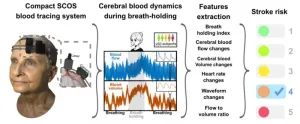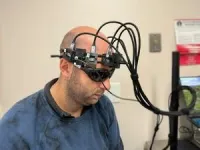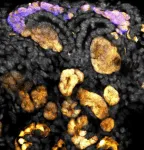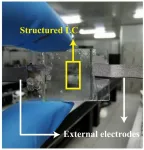(Press-News.org) WASHINGTON — Researchers have developed a laser-based device that can be placed on the head to non-invasively monitor changes in brain blood flow and volume. The new device could one day help save lives by offering a direct and simple way to assess stroke risk based on physiological markers rather than indirect markers like lifestyle factors.
Strokes occur when blood flow to the brain is blocked or reduced, causing debilitating brain cell damage. With about 15 million people worldwide affected by strokes each year, it is the second leading cause of death and a leading cause of long-term disability.
“The lack of a cost-effective and scalable stroke risk assessment system complicates long-term stroke prevention because a physician can’t tell whether a patient’s risk is stable or worsening,” said research team member Simon Mahler, a postdoctoral scholar in Changhuei Yang’s laboratory at the California Institute of Technology. “This new method could help catch early signs of increased stroke risk, which is key to lowering the chances of having a stroke and reducing stroke severity.”
In the Optica Publishing Group journal Biomedical Optics Express, the researchers describe their approach, which uses speckle contrast optical spectroscopy (SCOS) to track changes in blood flow and volume during a breath-holding exercise. They report that the portable system was able to differentiate between low and high stroke risk in a group of 50 volunteers. The work is part of a larger collaboration led by Yang and Charles Liu from the University of Southern California.
“This approach could one day be incorporated into the regular testing performed during annual physical examinations, providing physicians with crucial information about the patient’s health,” said Liu. “It could be particularly beneficial for communities with limited access to advanced medical facilities and has the potential to lead to personalized strategies for reducing stroke risk.”
Spectroscopy on the go
For the past 40 years, researchers have been experimenting with various methods to measure blood flow in the brain and changes associated with stroke risk. Measuring blood flow when the brain is stressed, such as during breath holding, can be used to assess the risk of stroke.
Although imaging techniques like PET, SPECT and CT can reveal changes in blood flow, they are expensive and aren't easy to use in clinics or for widespread community screening. To solve this challenge, the researchers turned to SCOS as a more practical way to access changes in blood flow and volume in the brain. They built a simple, portable spectroscopy system that consists of a laser diode and a CMOS-based camera that can be placed on the head with no external optical elements.
SCOS works by shining an infrared laser or light onto the brain and analyzing the patterns of scattered light. The infrared light can penetrate the skull and brain, producing a back-scattered speckle pattern that varies with changes in blood flow and tissue oxygenation. Using a coherent laser makes it possible to determine brain blood flow rate by calculating how fast the captured laser speckle field fluctuates, which speeds up with faster blood flow.
Simplified blood flow assessment
“As people age their blood vessels get stiffer, making them more prone to stroke,” said Yang. “By asking a person to hold their breath, we can use SCOS to measure how much the blood vessels expand and how much faster blood is flowing within the vessels in response. These reactive measurements are indicative of vessel stiffness, and such measurement capabilities are unique to transcranial optical methods.”
The researchers tested the SCOS method with 50 people who were divided into low- and high-risk stroke groups based on a stroke risk assessment performed with the Cleveland Stroke Risk Calculator. The researchers found that blood flow and blood volume changes were significantly different between the two groups and, therefore, have the potential to serve as physiological markers for stroke risk.
“While the current study is very promising, we are planning additional studies to further understand the clinical implications of the laser SCOS recordings in larger patient groups over longer time periods,” said Liu. They are also working to incorporate machine learning to improve data analysis and further validate the method’s effectiveness.
Paper: Y. X. Huang, S. Mahler, A. Abedi, J. M. Tyszka, Y. T. Lo, P. D. Lyden, J. Russin, C. Liu, and C. Yang, “Correlating stroke risk with non-invasive cerebrovascular perfusion dynamics using a portable speckle contrast optical spectroscopy laser device,” Biomed. Opt. Express, volume 15, issue 10, pp. 6083 (2024).
DOI: https://doi.org/10.1364/BOE.534796
About Biomedical Optics Express
Biomedical Optics Express serves the biomedical optics community with rapid, open-access, peer-reviewed papers related to optics, photonics and imaging in biomedicine. The journal scope encompasses fundamental research, technology development, biomedical studies and clinical applications. It is published monthly by Optica Publishing Group and edited by Christoph Hitzenberger, Medical University of Vienna, Austria. For more information, visit Biomedical Optics Express.
About Optica Publishing Group
Optica Publishing Group is a division of the society, Optica, Advancing Optics and Photonics Worldwide. It publishes the largest collection of peer-reviewed and most-cited content in optics and photonics, including 18 prestigious journals, the society’s flagship member magazine, and papers and videos from more than 835 conferences. With over 400,000 journal articles, conference papers and videos to search, discover and access, our publications portfolio represents the full range of research in the field from around the globe.
Media Contact:
mediarelations@optica.org
END
New wearable laser device monitors brain blood flow to gauge stroke risk
Device offers an inexpensive and simple way to detect early physiological signs of increased stroke risk
2024-09-30
ELSE PRESS RELEASES FROM THIS DATE:
BU professor receives $29M NIH grant to study dementia risk factors, prevention, and treatment
2024-09-30
FOR IMMEDIATE RELEASE
Monday, September 30, 2024
Contact:
Jillian McKoy, jpmckoy@bu.edu
Michael Saunders, msaunder@bu.edu
##
BU Professor Receives $29M NIH Grant to Study Dementia Risk Factors, Prevention, and Treatment
The Triangulation of Innovative Methods to End Alzheimer’s Disease project will use large, diverse datasets to examine whether interventions targeting alcohol use, depression, vision or hearing impairments, or social isolation can protect people from Alzheimer’s disease and related dementias. This project is a collaboration among Dr. Maria Glymour at Boston University School of Public Health, Dr. Jacqueline ...
Ninth Circuit reverses lower court, reinforces FDA's authority to regulate unproven stem cell products
2024-09-30
In an important step to protect the public from unproven stem cell products, the U.S. Court of Appeals for the Ninth Circuit ruled in favor of the U.S. Food and Drug Administration in U.S. v. California Stem Cell Treatment Center, Inc., reversing the district court. The reversal fortifies FDA’s tiered, risk-based framework for the regulation of cell therapies and is consistent with a similar ruling in the Eleventh Circuit in 2021.
The appellees urged the Ninth Circuit to uphold the lower court’s ...
Wnt happens in kidney development?
2024-09-30
A group of essential signaling molecules known as the Wnt pathway emerged early in the evolution of multicellular life. Scientists have been studying Wnt actions for four decades to comprehend its complex roles in development and disease. In development of the mammalian kidney, USC Stem Cell scientists from Andy McMahon’s lab undertook a pair of complementary studies, published today in the journal Development, that provide new insight into the critical role of Wnt signaling in initiating the development of the mammalian kidney.
“Many stem and progenitor cells require Wnt signaling, ...
Where flood policy helps most — and where it could do more
2024-09-30
Flooding, including the devastation caused recently by Hurricane Helene, is responsible for $5 billion in annual damages in the U.S. That’s more than any other type of weather-related extreme event.
To address the problem, the federal government instituted a program in 1990 that helps reduce flood insurance costs in communities enacting measures to better handle flooding. If, say, a town preserves open space as a buffer against coastal flooding, or develops better stormwater management, area policy owners get discounts on their ...
Combining AI and thermal video offers a new window into weightlifting
2024-09-30
WASHINGTON — Researchers have developed a new method that combines video from thermal cameras with AI-based digital processing to enhance weightlifting training. By providing data-driven insights that enable targeted training and recovery strategies, the approach could help to optimize performance and safety in a variety of sport and exercise contexts.
Thermal, or infrared, images can provide valuable information for sports and health by tracking muscle activation and detecting areas of strain or fatigue. This information can be used to prevent injuries, monitor thermal responses and quantify physical exercise, ultimately helping athletes boost their skills. However, most ...
Childhood social interactions combat stereotypes
2024-09-30
Prior research has found that exposure to social diversity in early life, such as through day care, influences how people communicate.
Those early social experiences can also moderate tendencies toward stereotyping down the road, according to a new study published in the NPJ Science of Learning.
"The more time an individual spent in day care as a child, the more likely they are to overcome their own stereotypical beliefs during social interactions later in life," says senior author Arjen Stolk, an assistant professor in the Department ...
Researchers harness liquid crystal structures to design simple, yet versatile bifocal lenses
2024-09-30
WASHINGTON — Researchers have developed a new type of bifocal lens that offers a simple way to achieve two foci (or spots) with intensities that can be adjusted by applying external voltage. The lenses, which use two layers of liquid crystal structures, could be useful for various applications such as optical interconnections, biological imaging, augmented/virtual reality devices and optical computing.
“Most liquid-crystal-based devices are made from single-layer structures, but this limits light field modulation ...
Suicide attempts decreased after adding suicide care to primary care, study finds
2024-09-30
After suicide care was integrated into routine primary care visits, researchers saw a 25% decrease in the rate of suicide attempts in the following 90 days, a new Kaiser Permanente study finds.
The study, published in the Annals of Internal Medicine, is the first to show that suicide risk screening in primary care, followed by safety planning, improved suicide prevention efforts in a health care setting. The trial took place at Kaiser Permanente clinics in Washington state, using data from January 2015 to July 2018.
“Our findings are important because we know many people seek primary care prior to fatal and nonfatal suicide attempts,” ...
One in three Americans has a dysfunctional metabolism, but intermittent fasting could help
2024-09-30
LA JOLLA (Sept 30, 2024)—More than one-third of adults in the United States have metabolic syndrome, a cluster of conditions that significantly raise a person’s risk of heart disease, stroke, and type 2 diabetes. These conditions include high blood pressure, elevated blood sugar, excess abdominal fat, and abnormal cholesterol levels.
In a new clinical trial, researchers at the Salk Institute and University of California San Diego School of Medicine found that time-restricted eating—also known as intermittent fasting—could offer significant health benefits to adults with metabolic syndrome. Patients ...
Time-restricted eating associated with greater blood sugar control and fat loss than standard nutrition counseling
2024-09-30
Embargoed for release until 5:00 p.m. ET on Monday 30 September 2024
@Annalsofim
Below please find summaries of new articles that will be published in the next issue of Annals of Internal Medicine. The summaries are not intended to substitute for the full articles as a source of information. This information is under strict embargo and by taking it into possession, media representatives are committing to the terms of the embargo not only on their own behalf, but also on behalf of ...
LAST 30 PRESS RELEASES:
Tracing the quick synthesis of an industrially important catalyst
New software sheds light on cancer’s hidden genetic networks
UT Health San Antonio awarded $3 million in CPRIT grants to bolster cancer research and prevention efforts in South Texas
Third symposium spotlights global challenge of new contaminants in China’s fight against pollution
From straw to soil harmony: International team reveals how biochar supercharges carbon-smart farming
Myeloma: How AI is redrawing the map of cancer care
Manhattan E. Charurat, Ph.D., MHS invested as the Homer and Martha Gudelsky Distinguished Professor in Medicine at the University of Maryland School of Medicine
Insilico Medicine’s Pharma.AI Q4 Winter Launch Recap: Revolutionizing drug discovery with cutting-edge AI innovations, accelerating the path to pharmaceutical superintelligence
Nanoplastics have diet-dependent impacts on digestive system health
Brain neuron death occurs throughout life and increases with age, a natural human protein drug may halt neuron death in Alzheimer’s disease
SPIE and CLP announce the recipients of the 2025 Advanced Photonics Young Innovator Award
Lessons from the Caldor Fire’s Christmas Valley ‘Miracle’
Ant societies rose by trading individual protection for collective power
Research reveals how ancient viral DNA shapes early embryonic development
A molecular gatekeeper that controls protein synthesis
New ‘cloaking device’ concept to shield sensitive tech from magnetic fields
Researchers show impact of mountain building and climate change on alpine biodiversity
Study models the transition from Neanderthals to modern humans in Europe
University of Phoenix College of Doctoral Studies releases white paper on AI-driven skilling to reduce burnout and restore worker autonomy
AIs fail at the game of visual “telephone”
The levers for a sustainable food system
Potential changes in US homelessness by ending federal support for housing first programs
Vulnerability of large language models to prompt injection when providing medical advice
Researchers develop new system for high-energy-density, long-life, multi-electron transfer bromine-based flow batteries
Ending federal support for housing first programs could increase U.S. homelessness by 5% in one year, new JAMA study finds
New research uncovers molecular ‘safety switch’ shielding cancers from immune attack
Bacteria resisting viral infection can still sink carbon to ocean floor
Younger biological age may increase depression risk in older women during COVID-19
Bharat Innovates 2026 National Basecamp Showcases India’s Most Promising Deep-Tech Ventures
Here’s what determines whether your income level rises or falls
[Press-News.org] New wearable laser device monitors brain blood flow to gauge stroke riskDevice offers an inexpensive and simple way to detect early physiological signs of increased stroke risk






